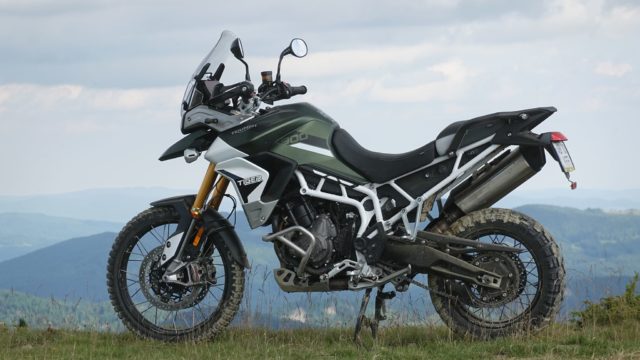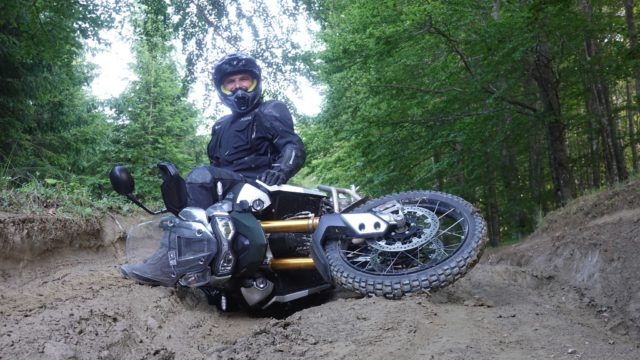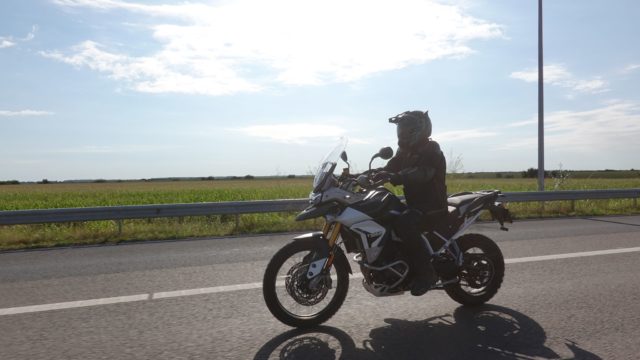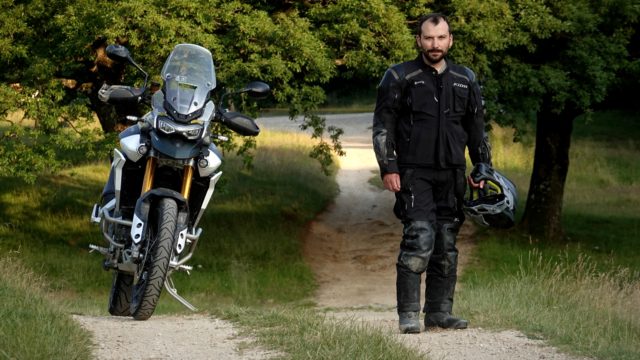Overall Ratings ★★★★★
| Ride: | ★★★★★ |
| Look: | ★★★★★ |
| Value for money: | ★★★★★ |
In a Nutshell
The Triumph Tiger 900 is not just an updated Tiger 800. It’s a completely new bike, a new generation, and it’s the most adventurous Tiger ever produced.
The Triumph Tiger 900 Range is consisting of two main versions: the street-oriented GT and GT Pro and the more adventurous Rally and Rally Pro. Of course, there’s also a standard Tiger 900 available.
We got our hands on the Tiger 900 Rally Pro, the top-spec version with all the goodies and fancy electronics. Since it’s coming with street tires as standard, we swapped them for some knobbies and went on a high altitude unpaved road in the Carpathians – one of our favorites in Romania.
Watch the full, in-depth video review above, and don’t forget to subscribe to our YouTube channel for more.
What We Liked
The Triumph Tiger 900 feels lighter in off-road. It’s more nimble, the standing riding position is better, with more control over the bike. Everything is very well put together, and everything is where it should be. The knee contact area doesn’t feel edgy as before, the engine is position lowered without affecting the ground clearance, and the radiator is split into two parts. It’s a very nice upgrade in the ergonomics sector.
The Triumph Tiger 900 frame is new, with a bolted-in aluminum subframe and detachable passenger foot-pegs. This was a must in the adventure-motorcycling sector, and it’s a big improvement over the previous version.
The air-filter is easier to access. You just have to take down the seat and use a screwdriver that you can find under the seat.
The new Triumph Tiger 900 comes with tubeless spoked tires and the Rally Pro version is offering all the tech you might wish for – IMU, riding modes, heated seat for you, and passenger. Also, you’re getting some fancy Brembo Stylema calipers.
The engine comes in larger volume and features a different firing order (1,3,2), and feels more responsive and with more grunt than before.

What We Disliked
Although offering more grunt than before, the Tiger 900 triple engine doesn’t feel as good as a twin, especially in off-road. You have to work a bit with the throttle, and there’s no engine brake to help you on steep slopes. Also, it’s not revving as fast as the old triple and it’s not so fun to ride it.
Although featuring the biggest TFT dash on the market, with different layouts, I couldn’t find one to match my preference. My problem is the way Triumph arranged the info – it’s hard to spot some essential information such as the riding mode or the tire pressure. By the way, the tire pressure sensor was always blinking. I thought it was something broken, but then I learned that, unless having the exact tire pressure mentioned in the manual, the red sign on the dash won’t disappear.
When turning off the engine in off-road, the engine automatically goes to the street riding mode, unless pressing two buttons. It’s also uncomfortable to switch the riding modes from street to off-road while on the go.
The new headlight doesn’t offer as much light as before, so you need some auxiliary lights if riding during the night.

Raw Data
|
TIGER 900 |
TIGER 900 GT |
TIGER 900 GT PRO |
TIGER 900 RALLY |
TIGER 900 RALLY PRO |
|
| Engine Type | Liquid-cooled, 12 valve, DOHC, in-line 3-cylinder | ||||
| Capacity | 888 cc | ||||
| Bore Stroke | 78 x 61.9 mm | ||||
| Compression | 11.27:1 | ||||
| Max Power | 95.2 PS / 93.9 bhp (70 kW) @ 8,750 rpm | ||||
| Max Torque | 87 Nm @ 7,250 rpm | ||||
| System | Multipoint sequential electronic fuel injection | ||||
| Exhaust | Stainless steel 3 into 1 header system, side mounted stainless steel silencer | ||||
| Final Drive | O-ring chain | ||||
| Clutch | Wet, multi-plate | ||||
| Gearbox | 6 speed | ||||
| Frame | Tubular steel frame, bolt on sub frame | ||||
| Swingarm | Twin-sided, cast aluminium alloy | ||||
| Front Wheel | Cast alloy, 19 x 2.5 in | Spoked Tubeless, 21 x 2.15 in | |||
| Rear Wheel | Cast alloy, 17 x 4.25 in | Spoked Tubeless, 17 x 4.25 in | |||
| Front Tyre | 100/90-19 | 90/90-21 | |||
| Rear Tyre | 150/70R17 | 150/70R17 | |||
| Front Suspension | Marzocchi 45mm upside down forks, non-adjustable | Marzocchi 45mm upside down forks, manual rebound and compression damping adjustment, 180mm travel (140mm GT LRH) | Showa 45mm upside down forks, manual preload, rebound damping and compression damping adjustment, 240mm travel | ||
| Rear Suspension | Marzocchi rear suspension unit, manual preload adjustment, 170mm rear wheel travel | Marzocchi rear suspension unit, manual preload and rebound damping adjustment, 170mm wheel travel (151mm LRH) | Marzocchi rear suspension unit, electronically adjustable preload and rebound damping, 170mm wheel travel | Showa rear suspension unit, manual preload and rebound damping adjustment, 230mm wheel travel | |
| Front Brake | Twin 320mm floating discs, Brembo Stylema 4 piston Monobloc calipers. Radial front master cylinder, ABS | Twin 320mm floating discs, Brembo Stylema 4 piston Monobloc calipers. Radial front master cylinder, Optimised Cornering ABS | Twin 320mm floating discs, Brembo Stylema 4 piston Monobloc calipers. Radial front master cylinder, Optimised Cornering ABS | ||
| Rear Brake | Single 255mm disc. Brembo single piston sliding caliper, ABS | Single 255mm disc. Brembo single piston sliding caliper. Optimised cornering ABS. | Single 255mm disc. Brembo single piston sliding caliper. Optimised cornering ABS | ||
| Width Handlebars | 830mm | 930mm | 930mm | 935mm | 935mm |
| Height (Without Mirrors) | 1410-1460mm | 1410-1460mm (1385-1435 mm LRH) | 1410-1460mm | 1452-1502mm | 1452-1502mm |
| Seat Height | 810-830mm | 810-830mm (760-780mm LRH) | 810-830mm | 850-870mm | 850-870mm |
| Wheelbase | 1556mm | 1556mm (1545mm LRH) | 1556mm | 1551mm | 1551mm |
| Rake | 24.6 º | 24.6 º (24.1 º LRH) | 24.6 º | 24.4 º | 24.4 º |
| Trail | 133.3mm | 133.3mm (130.0mm LRH) | 133.3mm | 145.8mm | 145.8mm |
| Dry Weight | 192 kg | 194 kg (193 kg LRH) | 198 kg | 196 kg | 201 kg |
| Tank Capacity | 20 L | 20 L | 20 L | 20 L | 20 L |

